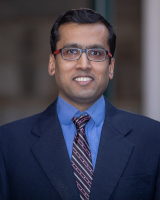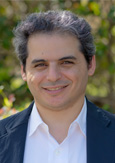Media
Contact
Communications Specialist
Faculty of Engineering
Spencer Engineering Building
Room 2072
Western University
Tel: 519-661-2111 ext. 87015
Email: engineeringcomms@uwo.ca
AI Engineering the Future: Advancements in Smart Cities

In recent years, the transformative potential of Artificial Intelligence (AI) and its applications have become increasingly evident. From healthcare to education, AI systems like ChatGPT have started to redefine our approaches to various fields, and Smart Cities are no exception.
Smart Cities represents a swiftly advancing interdisciplinary field that encompasses civil and environmental engineering, software engineering, communications, and others. It encompasses the utilization of cutting-edge technologies, such as sensors and advanced data acquisition and management systems, to enhance the resilience and efficiency of urban operations and infrastructure. Future urban areas will integrate sensing, communication, and management technologies seamlessly to maintain connected and adaptable built environments, enabling real-time monitoring for effective administration.
Currently, over half the world’s population lives in urban areas. In recent years, densely populated urban cities have transformed using smart technologies such as sensors, cameras, mobile data acquisition platforms, and other networked devices to gather data about an urban environment and its inhabitants. Such data and resulting decisions could make our cities and communities more resilient and sustainable against aging, natural disasters, climate change, or unprecedented events.
At Western Engineering, a group of dedicated researchers and experts have been delving into the role of AI in Smart Cities and its implications. Their valuable insights are as diverse as the promising landscape of Smart Cities itself. We will explore their visionary work, driven by the shared commitment to building a smarter, greener future.
Professor Ayan Sadhu: Implementing a 4R Monitoring System for Resilient Civil Infrastructure
 Civil and environmental engineering professor Ayan Sadhu aims to develop a rapid, remote, real-time, and robust (4R) monitoring system for structural construction and maintenance, ultimately leading to smarter and more cost-effective infrastructure management. This will result in faster construction and maintenance.
Civil and environmental engineering professor Ayan Sadhu aims to develop a rapid, remote, real-time, and robust (4R) monitoring system for structural construction and maintenance, ultimately leading to smarter and more cost-effective infrastructure management. This will result in faster construction and maintenance.
Sadhu explains, “decades of research in construction and maintenance have not prevented our civil infrastructure from deteriorating due to harsh weather and increased traffic, endangering our growing population.”
“Recent sensor technology advances offer civil engineers opportunities to create autonomous systems for quickly building new structures and inspecting aging ones in real time. Yet, challenges like human-sensor-structure interaction, remote implementation, and harsh environmental conditions persist.”
Sadhu's team is revolutionizing bridge inspection with cutting-edge technology. They're using advanced signal processing to inspect bridges in real-time by using passing vehicles and addressing the vehicle-sensor-bridge interaction. Additionally, they're deploying aerial and underwater drones with cameras and lidar for localized defect detection and classification in structures, all powered by AI.
“To improve accessibility and safety in construction and inspection sites, the team is creating immersive platforms with augmented/virtual reality glasses for real-time measurements,” he added. “They're also building digital twins of aging bridges by integrating internet-of-things (IoT) sensors with Building Information Modeling (BIM) to visualize structural health conditions in real-time.”
The advanced non-destructive techniques employ acoustic sensors to detect localized defects, and they have developed robust computer vision algorithms for inspecting real-world structures, even in the presence of low-level structural motion. Moreover, the team is working on energy-harvested sensors to manage remote structures, addressing the challenge of continuous power supply.
His research has received funding and support from the Natural Sciences and Engineering Research Council of Canada, the Early Researcher Award from the Ontario Ministry of Colleges and Universities, as well as contributions from municipalities and various industrial partners. In January 2024, a new research theme funded by the Western Academy for Advanced Research (WAFAR) will investigate the challenges and benefits that Smart Cities present. This WAFAR theme, Interdisciplinary Research to Address Technical and Social Barriers in Smart Cities and Communities, is led by Sadhu in collaboration with professor Abdallah Shami (department of electrical and computer engineering), and professor Anabel Quan-Haase (Faculty of Information and Media Studies, Sociology) and visiting European researchers. With his expertise in smart infrastructure, Sadhu has been selected as the Associate Editor of ASCE Journal of Bridge Engineering and the Royal Society Open Science.
Professor Soodeh Nikan: Enhancing Driver Safety in Autonomous Vehicles
 As vehicles progress towards higher levels of automation, it becomes imperative for these systems to be not only cutting-edge but also safe and seamlessly integrated with human behaviour. The research of Soodeh Nikan, an electrical and computing engineering professor, bridges this critical gap by extending beyond vehicle navigation and decision-making capabilities to enable vehicles to understand and adapt to their human occupants. She believes this comprehensive approach represents a significant stride toward making autonomous vehicles dependable and integral to our daily lives.
As vehicles progress towards higher levels of automation, it becomes imperative for these systems to be not only cutting-edge but also safe and seamlessly integrated with human behaviour. The research of Soodeh Nikan, an electrical and computing engineering professor, bridges this critical gap by extending beyond vehicle navigation and decision-making capabilities to enable vehicles to understand and adapt to their human occupants. She believes this comprehensive approach represents a significant stride toward making autonomous vehicles dependable and integral to our daily lives.
“We are not just focusing on traditional vehicle safety measures; instead, we're harnessing the power of cabin cameras combined with artificial intelligence to enhance safety,” said Nikan.
“These cameras excel in real-time monitoring of various factors, including the driver's eye gaze, body posture, pupil dilation, facial expressions, and skin tone to gauge cognitive and emotional conditions serving as indicators for stress, illness, distraction or anger.”
Through cabin cameras and AI, her research aims to create a real-time safety net in autonomous vehicles. This technology not only enhances driver safety but also paves the way for a smoother transition between human and autonomous control, potentially saving lives and reducing accidents.
“By intelligently analyzing a driver’s state and readiness, we can offer a solution that makes handing control back and forth between human and machine both safe and efficient," she added.
Professor Mohamed Zaki: Revolutionizing Urban Mobility with AI
 Civil and environmental engineering professor Mohamed Zaki, an AI and traffic management expert, envisions a future where urban mobility is safer and more efficient. His research harnesses AI to evaluate traffic conditions accurately, predict safety impacts during emergencies, and study pedestrian behaviour. By integrating AI into urban mobility, Zaki contributes to making cities more accessible and secure for all residents.
Civil and environmental engineering professor Mohamed Zaki, an AI and traffic management expert, envisions a future where urban mobility is safer and more efficient. His research harnesses AI to evaluate traffic conditions accurately, predict safety impacts during emergencies, and study pedestrian behaviour. By integrating AI into urban mobility, Zaki contributes to making cities more accessible and secure for all residents.
"Our innovative approach employs advanced AI-driven traffic safety techniques and simulation models based on real traffic data to accurately assess and predict traffic conditions,” he said.
“It includes using predictive modelling to evaluate the safety implications of adaptive cruise control during events like hurricane evacuations and to estimate traffic delays at urban intersections using Reinforcement Learning.”
Zaki’s work also focuses on the behaviour of active road users, including pedestrians, e-bike riders, and cyclists. His research has also made invaluable contributions to automated pedestrian data collection, including innovative methods to analyze walking behaviours accurately and create safety evaluation and planning models for pedestrian interactions in shared spaces. His work is deeply rooted in traffic safety initiatives, particularly those aimed at vulnerable communities like Vancouver's Downtown Eastside.
Beyond his research, Zaki has assumed a pivotal role in the Transportation Research Board (TRB), particularly within the Standing Committee of Artificial Intelligence and Advanced Computing Applications. His appointment as the co-chair of the paper review subcommittee since 2020 underscores his leadership and enduring influence in this pivotal domain.
Professor Katarina Grolinger: Redefining Building Energy Efficiency
 Electrical and computing engineering professor, Katarina Grolinger is leading a project in partnership with London Hydro, focusing on a critical aspect of smart cities—building energy consumption.
Electrical and computing engineering professor, Katarina Grolinger is leading a project in partnership with London Hydro, focusing on a critical aspect of smart cities—building energy consumption.
Buildings account for 40 percent of the world’s total energy consumption and as an expert in smart buildings, Grolinger, in collaboration with Miriam Capretz, a professor in electrical and computer engineering, and Girma Bitsuamlak, a professor in civil and environmental engineering, is exploring the symbiotic relationship between Smart Cities and intelligent architecture.
She explains, “Optimizing building performance requires technologies such as digital twins, artificial intelligence (AI), and Internet of Things.”
“A Digital Twin is a living digital model of the building that continually evolves alongside the real-world building based on real-time data from sensing/IoT systems. On the other hand, Machine Learning (ML) enables insights into building dynamics and establishes a platform for learning about how people use the buildings."
Grolinger’s work aims to revolutionize energy modelling and real-time monitoring by enhancing our understanding of energy systems and consumption patterns. Her research hopes to take us closer to achieving net-zero greenhouse gas emissions in buildings.
"Smart buildings are integral to Smart Cities, promoting energy efficiency, comfort and sustainability. It will make buildings more responsive to occupants' needs while minimizing their environmental impact,” she added.
Electrical and Computer Engineering Graduate Student Ibrahim Shaer: AI for Sustainable Warehousing
 Shaer works under the tutelage of professor Shami and is a member of the Optimized Computing and Communications (OC2) Laboratory. He explores the critical aspect of energy reduction in heating, ventilation, and air conditioning (HVAC) systems, often overlooked in warehouse settings.
Shaer works under the tutelage of professor Shami and is a member of the Optimized Computing and Communications (OC2) Laboratory. He explores the critical aspect of energy reduction in heating, ventilation, and air conditioning (HVAC) systems, often overlooked in warehouse settings.
“The thermal requirements of the warehouses’ multi-zonal space are challenged by the need to fulfill deliveries achieved by unloading and offloading operations,” he explained.
“This environment introduces intrusive outdoor air that disrupts the optimal thermal conditions, jeopardizing the freshness of perishable items, which is detrimental to the operators’ budgets and the Earth’s ecosystem. The HVAC control systems that instantly react to these changes can cause surges in electricity consumption, increasing carbon emissions,” he added.
He contends that warehouses are substantial energy consumers citing that in the United States, warehousing costs account for almost ten per cent of a company's revenues.
“My research focuses on implementing artificial intelligence techniques, when integrated, can predict occupancy patterns. When applied with HVAC strategies, it will help to reduce energy consumption, delivering cost savings and environmental preservation,” he said.
In a world where urbanization is on the rise, the work of these researchers from the Faculty of Engineering at Western is instrumental. Their collaborative efforts, driven by AI and innovative technologies, steer us toward smarter, greener, and more resilient cities and communities. The future of Smart Cities is promising and Western engineers continue to shape the urban landscape for a sustainable and vibrant tomorrow.

